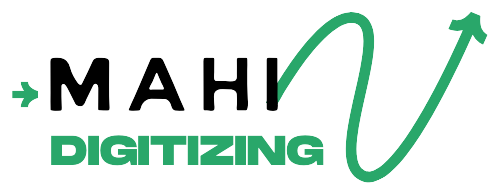Embroidery digitizing is a complex process that requires precision and expertise. Even small mistakes can affect stitch quality and production efficiency. Understanding common errors and how to avoid them ensures high-quality embroidery results.
Using Poor-Quality Source Images
One of the biggest mistakes in embroidery digitizing is working with low-resolution or pixelated images. Poor-quality images make it difficult to trace clean lines and accurate stitch paths, leading to rough or distorted embroidery.
Always use high-resolution vector images (SVG, AI, EPS) or clear raster images (PNG, JPEG) when converting designs into embroidery files. This ensures better stitch accuracy and maintains design integrity.
For professional vector conversion, check out our Vectorization Services at Mahi Digitizing.
Incorrect Stitch Density
Stitch density plays a crucial role in embroidery quality. Too many stitches in a small area cause thread breakage and fabric puckering, while too few stitches lead to gaps and poor coverage.
Proper digitizing software allows for adjusting stitch density based on fabric type and design complexity. Balancing density ensures smooth embroidery without damaging the fabric or causing production issues.
Learn more about optimizing stitch density with our Embroidery Digitizing Services.
Ignoring Underlay Stitches
Underlay stitches provide a stable foundation for embroidery, preventing distortion and ensuring smooth surface stitches. Many beginners skip this step, resulting in uneven and messy embroidery.
Proper underlay settings help stabilize the fabric and improve the final stitch-out quality. Common underlay types include edge run, left run, and zigzag, depending on the design and fabric.
Need help with underlay techniques? Visit our Custom Patches section for expert embroidery solutions.
Overcomplicating Small Lettering
Small text in embroidery designs often becomes unreadable due to excessive detail. Digitizing tiny letters with too many stitches leads to thread bunching and distortion.
To improve readability, use simple, bold fonts and increase letter spacing. Avoid serifs or decorative fonts for small text, and ensure a minimum height of 0.25 inches for best results.
Looking for clean, professional embroidery text? Explore our Embroidery Digitizing Services.
Not Adjusting for Fabric Type
Different fabrics react differently to embroidery stitches. A design that looks great on cotton may not work well on stretchy or delicate materials like silk or polyester.
Adjusting stitch type, density, and underlay based on fabric properties ensures consistent results. Soft fabrics need more stabilization, while thick fabrics may require longer stitches for better visibility.
Find out how we optimize embroidery for various materials in our Digitizing Solutions.
Improper Thread Tension and Pull Compensation
Incorrect thread tension leads to loops, breaks, or uneven stitches. Pull compensation is another critical factor, as stitches shrink slightly when embroidered.
Digitizers adjust pull compensation by slightly widening satin stitches and adding buffer space to prevent distortion. Proper calibration helps maintain design accuracy during production.
Need precision embroidery? Our Mahi Digitizing experts can help.
Conclusion
Avoiding common embroidery digitizing mistakes ensures better stitch quality, production efficiency, and professional-looking results. Proper digitizing techniques help prevent thread breakage, fabric puckering, and design distortion.
Whether you’re an embroidery business or a hobbyist, investing in expert digitizing services guarantees high-quality embroidery every time.
Get expert embroidery digitizing with Mahi Digitizing today.

